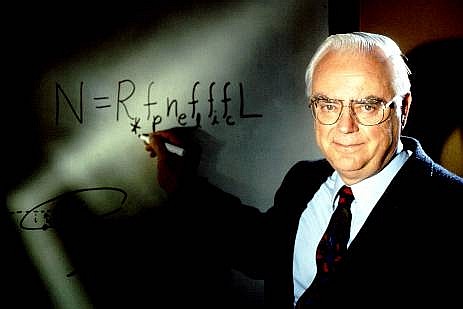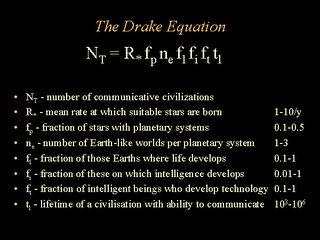



The Drake equation (also known as the Green Bank equation or the Sagan equation) is a famous result in the speculative fields of xenobiology, astrosociobiology and the search for extraterrestrial intelligence.
This equation was devised by Dr. Frank Drake (a professor at the University of California, Santa Cruz) in the 1960s in an attempt to estimate the number of extraterrestrial civilizations in our galaxy with which we might come in contact. The main purpose of the equation is to allow scientists to quantify the uncertainty of the factors which determine the number of extraterrestrial civilizations. In recent years, the Rare Earth hypothesis, which posits that conditions for intelligent life are quite rare in the universe has been seen as a possible refutation of the equation.
The Drake equation is closely related to the Fermi paradox. It was cited by Gene Roddenberry as supporting the multiplicity of starfaring civilizations shown in Star Trek, the television show he created.
The Drake equation states that:
N = R^{*} ~ \times ~ f_{p} ~ \times ~ n_{e} ~ \times ~ f_{l} ~ \times ~ f_{i} ~ \times ~ f_{c} ~ \times ~ L
where:
N is the number of civilizations in our galaxy with which we might expect to be able to communicate at any given time
and
R* is the rate of star formation in our galaxy
fp is the fraction of those stars which have planets
ne is average number of planets which can potentially support life per star that has planets
fl is the fraction of the above which actually go on to develop life
fi is the fraction of the above which actually go on to develop intelligent life
fc is the fraction of the above which are willing and able to communicate
L is the expected lifetime of such a civilization